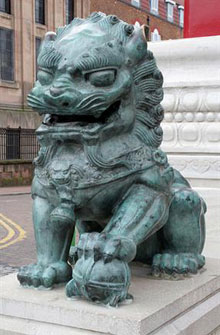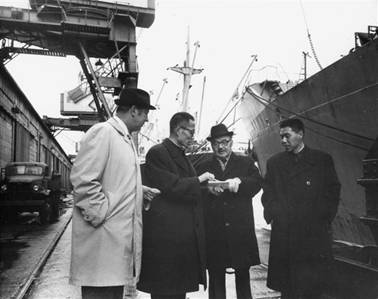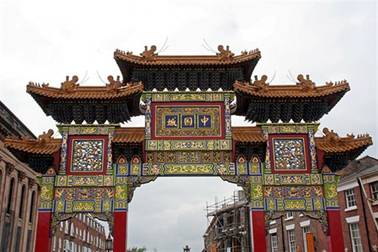Liverpool. When you think about the port city, crouching on the grey Mersey river in the northwest of England, the first things that springs to mind will probably be the Beatles, the Albert Dock, or the red-brick hulk of the Anglican cathedral. But Liverpool has a Chinese connection that stretches back to the very beginnings of Eastern trading, and is home to the one of the oldest Chinatowns in the world.
Liverpool is my home town. Growing up there, China was very much a part of life - my classmates whose parents were from Shanghai and Fujian, weekly trips to the Jade Lion restaurant, watching the dragon dance for Spring Festival. My maternal grandfather worked for Lambert Brothers, a big Liverpool shipping firm, and visited China many times throughout his career. Thus, his house was filled with souvenirs and travel relics from Beijing, Shanghai, and Hong Kong. Dinner parties often ended with shots of bai jiu and anecdotes of business deals struck just so, and the walls were decorated with ink paintings and calligraphy. With Liverpool being so inextricably linked with China, I decided to find out more about the city’s Chinese community, and its links with the Middle Kingdom past and present.

Thanks to its strategic position on the northwest coast of England, Liverpool has long been a centre of trade. A city built on the proceeds of the Industrial Revolution and, less illustriously, on the Atlantic slave trade, it was England’s busiest port in its heyday. A charter from the East India Company in 1834 opened trade routes between Europe and China, and Liverpool’s shipping firms were quick to cash in. The Holt Ocean Steamship Company set up a business wing called the Blue Funnel Line especially for trading with the Orient, and it sent its first ships to China in 1866 to collect tea and silk. Some of the Chinese sailors who came back the other way decided to stay on in Liverpool, so the Blue Funnel Line built boarding houses for them near the docks on Cleveland Square.
By 1871 there were 202 Chinese mariners living permanently in Liverpool. Just like modern western expats living in China, the Chinese who settled in England yearned for the comforts and traditions of home. Some opened laundries, while others started boarding houses and cafes where members of the burgeoning community could gather in order to speak their native language and eat Chinese food. These first businesses were opened on Pitt Street, a few blocks west of where the Anglican cathedral now stands.
The mariners had a good reputation among the Liverpudlians whose town they shared (Liverpool wasn’t granted city status until 1880). They were seen as responsible, sober, and non-violent, and many local women saw them as good husband material. Soon, mixed-race families were a common sight, with white women working in their Chinese husbands’ laundries and cafes.

The author’s grandfather (second from left)
After the First World War, the Chinese community began to spread into nearby Kent Street, Dickenson Street and Cornwallis Street. Along with the seamen who had settled permanently in Liverpool, there were also sailors on shore leave. The Blue Funnel Line had lent boats to the Navy during the war and not all of them had come back in one piece, so mariners often had to wait around in Liverpool until a ship became available to take them back to China. For want of anything better to do, they gambled. Betting houses sprang up, and the waiting sailors used their shore leave vouchers as chips. This was a worry to the local government, who feared for the moral fibre of these visiting shipmen. The city council opened up the Chinese Seamen’s Welfare Centre in 1917, hoping to save them from dissolution by providing a place for socialising outside of the gambling dens.
What happened next was to spell the end of Liverpool’s original Chinatown. During the 1930s, the municipal government started to tear down the old warehouses and tenements used by the Chinese community. Unsurprisingly, this didn’t go down too well, but the Chinese population had been decimated by the economic depression so nothing could be done. Then, as World War II gathered pace, German bombs landed on Pitt Street and Cleveland Square, ruining what the government hadn’t yet had time to raze.
During the war, there were around 20,000 Chinese in Liverpool. The active sailors among them were paid only a third of what their British colleagues earned, and weren’t entitled to the War Risk Bonus which would double British seamen’s salaries. The Chinese went on strike in February 1942, and didn’t cede until July when they were granted a pay rise and War Risk Bonus. However, their victory was short-lived as Liverpool’s governors now viewed them as troublemakers and consequently decided to repatriate them. They were refused shore jobs and forced to leave on one-way tickets. This spelled tragedy for many families. Over 300 women were left without husbands, and 1000 children were rendered fatherless. With little means of supporting themselves, some women gave their children up for adoption; others remarried local men who resented their mixed-race children. Liverpool’s Chinese community had been destroyed.

Vague plans to rebuild Chinatown were mooted in 1944 with a blueprint for a 12.5 acre space produced by a Chinese architecture student. Featuring a pagoda and a garden, the new area never saw the light of day as it was deemed too expensive. However, the community slowly regenerated. The late 40s and early 50s brought sailors from Hong Kong to Liverpool, giving the city the Cantonese influence that’s visible today. The Chinese Seamen’s Welfare Centre was reopened in 1947, and the Chinese Language School, China Bank, and Chinese News Weekly were given a new lease of life.
The area just north east of the original Chinatown was designated as the official home of Liverpool’s Chinese community in the 1970s. Nowadays, Nelson Street and Berry Street form the epicentre of modern Chinatown. A huge arch spans Nelson Street – the largest outside of China. Known as the Imperial Arch, it was assembled in the year 2000 using pieces imported from Shanghai. It stands 50 feet high and is made up of five roof segments decorated with 200 dragons and bronze lions, all conforming to feng shui specifications.
The arch, in all its magnificently gaudy glory, sums up how Chinese spirit has won out over injustice in Liverpool. Now just as much a part of the city as the Albert Dock and the Beatles Museum, Chinatown is one of Liverpool’s most popular areas, and the Chinese are very much locals now.
***
Related Links
China quarantines British school group over swine flu fears
Second China-UK Economic and Financial Dialogue reaches lots of consensus
Guangzhou's African Communities
Warning:The use of any news and articles published on eChinacities.com without written permission from eChinacities.com constitutes copyright infringement, and legal action can be taken.
All comments are subject to moderation by eChinacities.com staff. Because we wish to encourage healthy and productive dialogue we ask that all comments remain polite, free of profanity or name calling, and relevant to the original post and subsequent discussion. Comments will not be deleted because of the viewpoints they express, only if the mode of expression itself is inappropriate.
Please login to add a comment. Click here to login immediately.